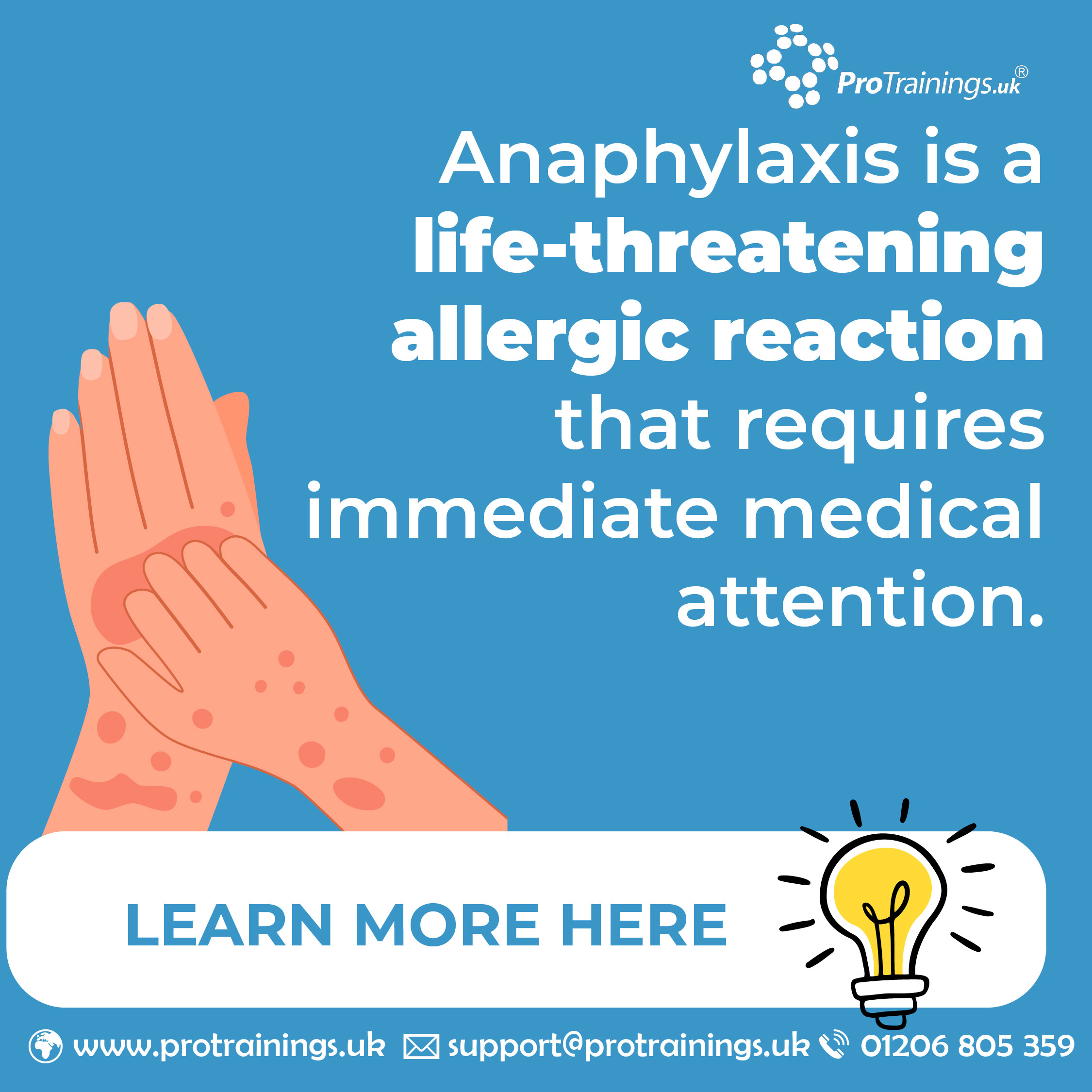Severe Allergic Reactions (Anaphylaxis):
Recognising and Responding to Anaphylactic Shock
Anaphylaxis is a severe, life-threatening allergic reaction that can occur suddenly after exposure to an allergen, such as certain foods, insect stings, or medications. Anaphylactic shock can cause the body’s immune system to overreact, leading to difficulty breathing, swelling, and a dangerous drop in blood pressure. Immediate first aid is critical in preventing serious complications or death.
What is Anaphylaxis?
Anaphylaxis is the body’s extreme response to an allergen, where the immune system releases a flood of chemicals that can cause shock. It often happens within minutes of exposure to the allergen and can progress rapidly. The most common allergens that trigger anaphylaxis include:
- Foods: Peanuts, tree nuts, shellfish, eggs, milk, and soy.
- Insect Stings: Bees, wasps, and hornets.
- Medications: Antibiotics (like penicillin), aspirin, or other non-steroidal anti-inflammatory drugs (NSAIDs).
- Latex: Certain medical gloves and other rubber-based products.
Signs and Symptoms of Anaphylaxis
Anaphylaxis can vary from mild to severe, and the symptoms usually appear suddenly. The most common symptoms include:
- Breathing Difficulties: Wheezing, shortness of breath, or a tight feeling in the chest.
- Swelling: Swelling of the face, throat, tongue, and lips, which can make breathing and swallowing difficult.
- Skin Reactions: Itchy, red hives or a widespread rash.
- Rapid Pulse: A fast, weak pulse is a sign that the heart is struggling to pump blood effectively.
- Low Blood Pressure: The person may feel dizzy or faint, and their skin may be pale or clammy.
- Nausea and Vomiting: The person may experience stomach pain, vomiting, or diarrhoea.
- Loss of Consciousness: As blood pressure drops further, the casualty may lose consciousness.
- Anxiety or Confusion: The person may feel anxious or confused as the reaction progresses.
First Aid for Anaphylaxis
Anaphylaxis is a medical emergency, and immediate action can save a life. The key treatment for anaphylaxis is the administration of adrenaline (epinephrine) through an auto-injector, such as an EpiPen, Jext, or Emerade.
- Call 999 Immediately:
- Dial 999 as soon as you suspect anaphylaxis. This is a medical emergency, and the casualty needs professional help.
- Inform the operator that the person is experiencing anaphylaxis, so they understand the urgency.
- Use an Adrenaline Auto-Injector:
- If the casualty has an adrenaline auto-injector, help them use it immediately. Auto-injectors are pre-loaded with a single dose of adrenaline and are designed to be used easily by anyone.
- Follow these steps:
- Remove the safety cap.
- Place the injector firmly against the outer thigh, at a right angle (it can be used through clothing if necessary).
- Push down until you hear a click, indicating that the needle has been released.
- Hold the injector in place for 10 seconds to ensure the full dose is delivered.
- Remove the injector and massage the injection site for 10 seconds to help the medication absorb.
- Adrenaline works quickly to reverse the symptoms of anaphylaxis by relaxing the airways, reducing swelling, and raising blood pressure.
- Help Them Stay Calm and Sit Comfortably:
- Help the casualty to sit upright if they are having difficulty breathing. If they feel faint or weak, you may need to lie them down with their legs raised slightly to help improve blood flow. If they are unconscious, place them in the recovery position.
- Reassure the person, as panic can make breathing difficulties worse.
- Monitor Their Condition:
- Continue to monitor the person’s breathing, pulse, and level of consciousness while waiting for emergency help.
- If symptoms do not improve or worsen after 5-10 minutes, a second dose of adrenaline may be needed if available.
- Be Prepared to Perform CPR:
- If the person loses consciousness and stops breathing, be prepared to perform CPR. Follow the instructions from the emergency operator, if applicable, until professional help arrives.
After an Anaphylactic Reaction
Even if the person’s symptoms seem to improve after using adrenaline, they should still receive medical attention. Anaphylaxis can sometimes cause a biphasic reaction, where symptoms return after a few hours. The person will likely be monitored in hospital for several hours to ensure they remain stable.
When to Seek Medical Help
Anaphylaxis is always a medical emergency, and you should call 999 immediately if:
- The person is struggling to breathe, has swelling in their throat or mouth, or is losing consciousness.
- They experience severe itching, hives, or swelling after exposure to an allergen.
- They have previously experienced an anaphylactic reaction and are showing similar symptoms.
Preventing Anaphylaxis
- Avoid Known Allergens: People with severe allergies should avoid known triggers, whether foods, medications, or insect stings. Labels on food products should be checked carefully, and restaurants or caterers should be informed of any allergies.
- Carry an Adrenaline Auto-Injector: Those at risk of anaphylaxis should always carry an auto-injector with them and know how to use it. Family, friends, and colleagues should also be aware of how to help in an emergency.
- Wear Medical Identification: Medical bracelets or identification cards can help others recognise a person’s allergies in an emergency.
Key Points to Remember
- Anaphylaxis is a life-threatening allergic reaction that requires immediate medical attention.
- Use an adrenaline auto-injector as soon as symptoms appear, and call 999 immediately.
- Help the person stay calm and monitor their condition while waiting for emergency help.
- Always seek medical attention, even if symptoms improve after using adrenaline.
